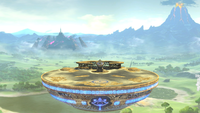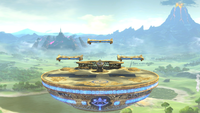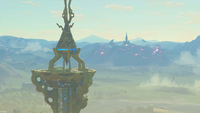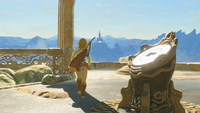Great Plateau Tower
| The Legend of Zelda: Breath of the Wild Great Plateau Tower | |
|---|---|
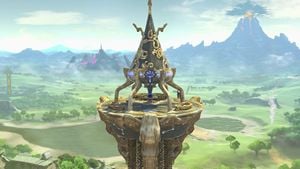  Great Plateau Tower in Super Smash Bros. Ultimate. | |
| Universe | The Legend of Zelda |
| Appears in | Ultimate |
| Availability | Starter |
| Crate type | Normal |
| Maximum players | 8 |
| Article on Zelda Wiki | Great Plateau Tower |
| “ | This is the tower everyone visits first in The Legend of Zelda: Breath of the Wild. The top part of the tower can be destroyed after taking damage, but will come back eventually. You can spot a certain Old Man in the background, watching over the match... | ” |
| —Super Smash Blog, Super Smash Bros. Ultimate Official Site | ||
Great Plateau Tower (始まりの塔, Tower of the Beginning) is a stage in Super Smash Bros. Ultimate.
Stage overview
The stage is a completely flat surface with a medium-sized structure above the middle of the floor acting as a ceiling. When hazards are on, the ceiling is destructible through two methods, which are by either damaging it with an attack, or having an opponent collide against it when they're being knocked back. The ceiling in the middle of the stage is relatively fragile, as it takes around 60%-65% damage to completely destroy it when normally attacking it. However, the amount of knockback needed for a character's collision to destroy it in one hit varies due to multiple factors. When destroyed, it gets replaced with a single soft platform on the middle of the stage until it is eventually rebuilt. When stage hazards are turned off, the structure becomes indestructible.
Occasionally, the Old Man paraglides onto the tower, stays for some time, and then paraglides away from the tower. He can also occasionally be seen gliding in the background behind the tower. He does not affect the battle.
Ω form and Battlefield form
The Ω form and Battlefield form are set on top of the tower similarly to its regular form; however, in both forms the stage is now suspended far above the ground with the top structure absent, and the main platform's walls resemble the bottom portion of the top structure. The stages are also resized and reshaped to match Final Destination and Battlefield, respectively. The three soft platforms of the Battlefield form are smaller versions of the soft platform in the regular form.
Origin
This stage is based on the Great Plateau Tower from The Legend of Zelda: Breath of the Wild, which is the first Sheikah Tower Link climbs and activates. Upon being activated, other Sheikah Towers begin to rise throughout Hyrule and Ancient Shrines activate. He also receives a detailed map of the Great Plateau region. Other Sheikah Towers also allow Link to have a map of the region in which the tower is located.
In the beginning of Breath of the Wild, the first person Link encounters after emerging from the Shrine of Resurrection is an Old Man who helps Link begin his journey by giving him items and tips about using the Sheikah Slate. After Link completes four Ancient Shrines, the Old Man reveals to him his true identity as the former king of Hyrule, King Rhoam. He tells Link the events leading up to him being in the Shrine of Resurrection, and gives him his paraglider to aid him on his journey to save Princess Zelda and Hyrule.
Tournament Legality
The stage is banned, as the ceiling that appears with stage hazards both on and off can create a cave of life effect.
Gallery
All Zelda universe characters on the stage.
Male and Female Corrins on the stage.
Dark Samus charging her forward smash.
Names in other languages
Trivia
- The soft platform when the pillar gets destroyed has Sheikah letters on it. When the letters are put together, they spell out "Smash Bros.", similar to the Hylian text on Temple post-Brawl.
- There is a small section of solid floor on top of the pillar which can be landed on, however doing so results in an immediate KO as it extends above the upper blast line.
- However, if the Devil moves the camera upwards (and the blast zones along with it), it is possible to stand on this floor until the upper blast zone moves back down again.
- The view behind the tower does not match up with its appearance in Breath of the Wild. Hyrule Castle is almost directly to the left of the pedestal's face, while the castle is more so behind it in Smash.
- The Ω form of Great Plateau Tower is very similar to the floating platform on which Link fights Monk Maz Koshia.
- Even in the Omega or Battlefield forms of the stage, the shadow for the tower can be seen on the ground if the camera is angled properly.
- This is the only new stage in Ultimate to not have any unlockable characters fought here outside DLC and World of Light.
- Despite Breath of the Wild having a day and night cycle, it always appears to be morning in the stage as opposed to others such as Gaur Plain and Smashville which have this feature.
- Thwomp, Arcade Bunny and the Squid Sisters cannot be summoned from an Assist Trophy on this stage. Additionally, Alolan Exeggutor cannot be summoned from a Poké Ball here.
